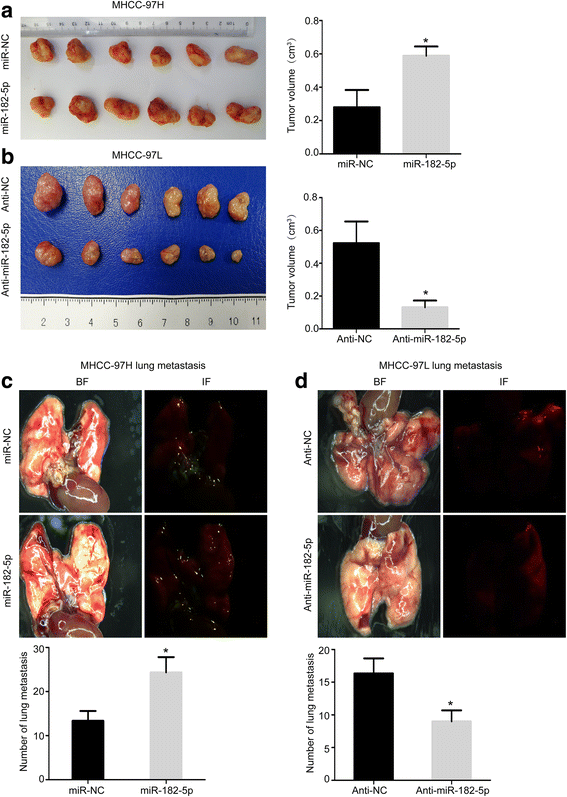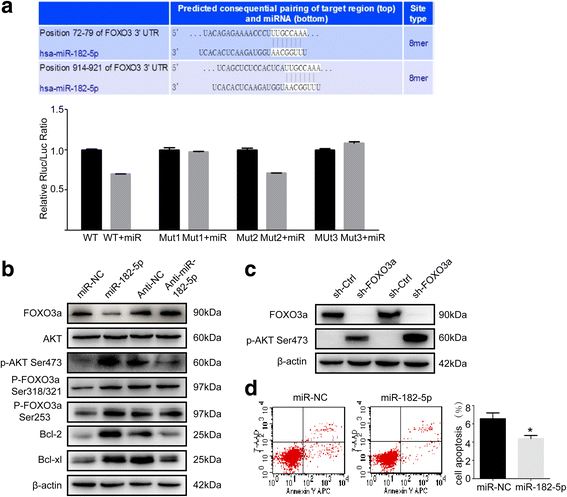miR-182-5p promotes hepatocellular carcinoma progression by repressing FOXO3a
- PMID: 29361949
- PMCID: PMC5782375
- DOI: 10.1186/s13045-018-0555-y
miR-182-5p promotes hepatocellular carcinoma progression by repressing FOXO3a
Erratum in
-
Correction to: miR-182-5p promotes hepatocellular carcinoma progression by repressing FOXO3a.J Hematol Oncol. 2018 Apr 18;11(1):56. doi: 10.1186/s13045-018-0599-z. J Hematol Oncol. 2018. PMID: 29669588 Free PMC article.
Abstract
Background: High frequency of recurrence is the major cause of the poor outcomes for patients with hepatocellular carcinoma (HCC). microRNA (miR)-182-5p emerged as a high-priority miRNA in HCC and was found to be related to HCC metastasis. Whether the expression of miR-182-5p in tumor tissue correlated with early recurrence in HCC patients underwent curative surgery was unknown.
Methods: Real-time PCR (RT-PCR) and in situ hybridization (ISH) were conducted to assess the expression of miR-182-5p in HCC cells and tissues. Cell Counting Kit-8 (CCK-8), transwell assays were performed to detected cells proliferation and migration ability. Flow cytometry assays were used to detect cell apoptosis rate, and xenograft model was employed to study miR-182-5p in HCC growth and lung metastasis. The target of miR-182-5p was validated with a dual-luciferase reporter assay and western blotting. Immunohistochemistry, immumoblotting, and immunoprecipitation were performed to test relative protein expression.
Results: We showed that high expression of miR-182-5p in tumor tissues correlated with poor prognosis as well as early recurrence in HCC patients underwent curative surgery. miR-182-5p enhanced motility and invasive ability of HCC cells both in vitro and in vivo. miR-182-5p directly targets 3'-UTR of FOXO3a and repressed FOXO3a expression, activating AKT/FOXO3a pathway to promote HCC proliferation. Notably, miR-182-5p activated Wnt/β-catenin signaling by inhibiting the degradation of β-catenin and enhancing the interaction between β-catenin and TCF4 which was mediated by repressed FOXO3a.
Conclusions: Consistently, miR-182-5p can be a potential predictor of early recurrence for HCC patients underwent curative surgery, and FOXO3a plays a key mediator in miR-182-5p induced HCC progression.
Keywords: FOXO3a; HCC; Wnt signaling; miR-182-5p.
Conflict of interest statement
Ethics approval and consent to participate
This study was approved by the clinical research ethics committee of the Shanghai Zhongshan Hospital of Fudan University.
Consent for publication
All the patients that involved in the study have given their consent to publish their individual data.
Competing interests
The authors declare that they have no competing interests.
Publisher’s Note
Springer Nature remains neutral with regard to jurisdictional claims in published maps and institutional affiliations.
Figures






References
-
- Ura S, Honda M, Yamashita T, Ueda T, Takatori H, Nishino R, Sunakozaka H, Sakai Y, Horimoto K, Kaneko S. Differential microRNA expression between hepatitis B and hepatitis C leading disease progression to hepatocellular carcinoma. Hepatology. 2009;49:1098–1112. doi: 10.1002/hep.22749. - DOI - PubMed
-
- Krol J, Loedige I, Filipowicz W. The widespread regulation of microRNA biogenesis, function and decay. Nat Rev Genet. 2010;11:597–610. - PubMed
Publication types
MeSH terms
Substances
LinkOut - more resources
Full Text Sources
Other Literature Sources
Medical
Molecular Biology Databases
Research Materials

